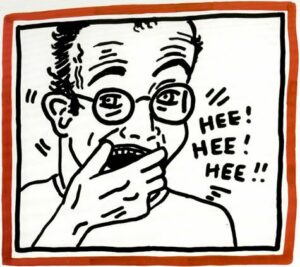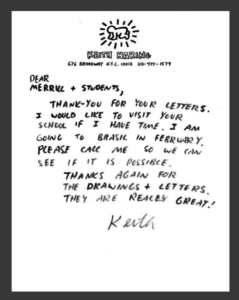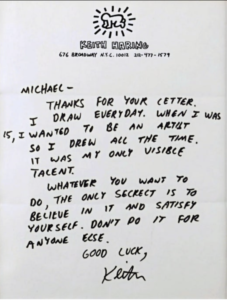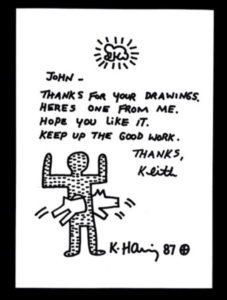
“Whatever you want to do, the only secret is to believe in it and satisfy yourself. Don’t do it for anyone else.” – Keith Haring
Printed above these words in block-like lettering was the trademark “Keith Haring” letterhead and iconic Radiant Baby symbol, giving the artist ownership of this unconventional canvas. Since his rise to fame, Keith Haring’s art has continuously appeared amongst our society and has remained a name that holds artistic and intellectual currency all on its own. The genius of Haring’s art has been captured on countless mediums, both of his own accord and that of the Keith Haring Foundation. From consumer items like skateboards and sweatshirts, to the church walls off Pisa, Italy, to children’s hospitals, and even on inconspicuous letters and envelopes.

Keith received lots of fan mail during his time as a superstar artist, and he responded to many of these letters, all of them circa 1987. For non-collectors, and those uninitiated in the valuation of blue chip artists and their work, these unassuming “artworks” can easily be mistaken for a simple outdated form of correspondence with little value. But when it comes to artists like Keith Haring, our perception of what is and what isn’t “artwork” tends to expand indefinitely. Anything the artist created seems to become instantly imbued with the same prestige and mystification of one of his paintings or prints. The art world would tend to agree, as the valuation of Haring’s personal letters to fans validates may surprise many, and certainly validates his position as a blue chip artist.
For many, it becomes clear that Haring used these letters as a medium to create. Giving us a closer look into the emotions the artist had felt towards the end of his life, the letters have both the words and the drawings that allow for a glimpse into a very personal part of his personality. At the same, much of Keith Haring’s art was always severely personal, but it never sacrificed that connection to a more universal language he sought to generate with his (mostly) innocuous signs and symbols. The letters offer us insight into Haring’s mind as an artist nearing the end of his career and life. In many letters, he speaks with young aspirational artists, giving them, and all of us reading, advice from the heights of his career.

Haring had shared his words through this form of communication with multiple individuals and organizations. He received an ample amount of fan mail on a variety of subjects—some included invitations, others were letters of gratitude, thanking Haring for his work and his profound effect on the world of street art. Other letters have alluded to fans sending Haring their own sketches, to which he would reply with thanks and a few sketches of his own. In these cases, an original sketch or doodle from the artist accompanying a personal message seems to fall in the same category as one of his original works. The same may be said for many blue chip artists, but especially when it comes to Keith Haring. With his cartoonish style, he pioneered his own brand of pop art that elevated the concept of “doodles” or sketches to high art, and lends itself to the ultimate truth of the genre: in the words of Andy Warhol “Pop art is for everyone.”

Interestingly, Haring was in a relatively consistent correspondence with an individual named Michael, later referred to as Mike. Although the exact relationship between Haring and Michael cannot be assumed, the two shared multiple correspondences near the end of the artist’s life. The origins of their correspondence can be traced back to Michael originally reaching out to the artist and sharing kind words about his art. The letter Michael had sent asked Haring about his early years as an artist, giving the artist a chance to openly share about his artistic upbringing in a non-published letter. As their correspondence continued, Haring began eventually attaching some sketches when writing his letters to Mike. Haring noted in the letters that he appreciated the time Mike had put in to continue to write to him, so the least he could do is offer some more of his art. Another letter discovered shows the artist inviting Mike to visit the studio and view his art.
 These correspondences, once a simple and inconspicuous part of Haring’s life, have allowed for a deeper understanding into what Haring had thought of his own work, as well as how he received the knowledge of the affects his art had on his fans. For collectors and Keith Haring fans, the value is clearly there. Currently, the letters are offered on auction websites for around $80,000, each letter being unique and some containing unique drawings. Quite a hefty price tag, but one that comes with a great deal of history and understanding of one of his generation’s greatest artists. The letters reappearance in society and their monetary significance further allow for an appreciation of Keith Haring. Haring was a world-renowned artist by the end of his life, but this did not stop him from engaging with those that his art had a profound effect on. As time passes, it will be interesting to see if more letters come to light and if there can be more art rediscovered by the late and great Keith Haring.
These correspondences, once a simple and inconspicuous part of Haring’s life, have allowed for a deeper understanding into what Haring had thought of his own work, as well as how he received the knowledge of the affects his art had on his fans. For collectors and Keith Haring fans, the value is clearly there. Currently, the letters are offered on auction websites for around $80,000, each letter being unique and some containing unique drawings. Quite a hefty price tag, but one that comes with a great deal of history and understanding of one of his generation’s greatest artists. The letters reappearance in society and their monetary significance further allow for an appreciation of Keith Haring. Haring was a world-renowned artist by the end of his life, but this did not stop him from engaging with those that his art had a profound effect on. As time passes, it will be interesting to see if more letters come to light and if there can be more art rediscovered by the late and great Keith Haring.
